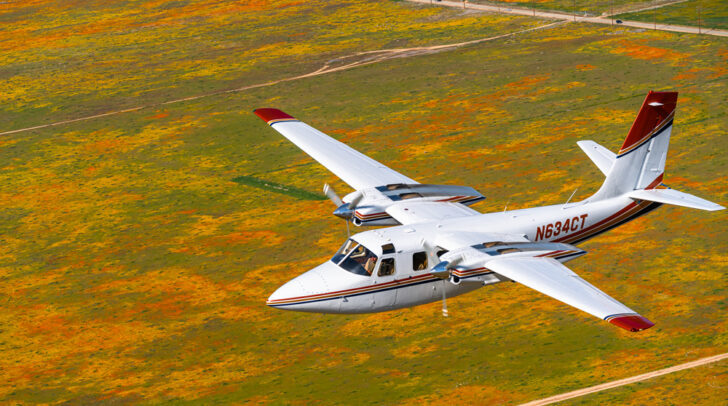
Photo by Simon A. Butusov Art
A flight school isn’t necessarily the first place you’d expect to find a Shrike, but Corsair Aviation in Van Nuys, California, isn’t a normal flight school. In addition to being a Cessna Pilot Center, the company offers charter in their fleet of single engine Cessnas, and with the recent acquisition of a Shrike from Northern Wings Aviation in Montana, customers can now ride in style all over the Southwest.
Mike Killian is the company’s chief pilot and owner, and he has big plans for the airplane. “We’ve been wanting to grow, but it can be kind of tough to do it with light aircraft,” he said. “Opportunities in government contracting is what is driving my interest.” Having only acquired the airplane late last year, Killian wanted to get it to work quickly, and was able to add the Shrike to the company’s charter certificate in a few short months. But charter, while important, is a supplement to his ultimate goal of using the Shrike on a variety of contracts, including air attack for fire season, aerial mapping and survey, and aerial photography.

Although Killian doesn’t have air attack experience, he got to see the breath of fire fighting operations while flying news helicopters that covered fires. Plus, the as-needed nature of forestry service contracts means Corsair can continue to use the airplane for other tasks when not flying forestry jobs. The company has already been successful in securing a contract from the Department of the Interior, and the forestry piece is coming up soon. After that Killian expects it to be a year of work on pilot and aircraft conformity approvals before they can be called.
Getting the right airplane was key to helping secure the contracts. Killian considered a Twin Cessna. They are plentiful, people know how to work on them, and it’s a natural step for pilots. But a 340 or something similar would have been limited to charter only, and special missions would have been out of the question. The Commander fits the company’s needs perfectly, and for less money. “We lucked out because this airplane became available and we jumped on it,” he said. It was already on a 135 certificate, so the maintenance records were tidy, and it was well maintained on a progressive schedule.
Killian said the interior is functional, but when government employees need to travel from point to point, luxury isn’t a priority. He’s in the process of upgrading the Commander to a standard that charter customers demand. “I believe if it looks good, it feels good,” he said.

The panel currently includes a Garmin 430 and 530, but as a potential step-up for the company’s flight instructors, Killian wants to make the Commander a seamless transition. He’s planning to upgrade to a Garmin G600 and 650/750.
That step-up plan is part of Killian’s philosophy. Students turn into instructors, who turn into single-engine charter pilots, who turn into Commander charter pilots, who may some day turn into air attack pilots. And if they’re successful with the Shrike, the plan is to move to a turbine-powered Twin Commander. He’s aware that the fire attack system is moving away from piston assets, but he believes it is a good place to start, and that they can provide an important back-up during a busy season.
Surprisingly, charter has some of the same challenges. In Southern California, where there is an abundance of jet charter options and good airline service, Corsair is offering a service at a price point where many potential customers aren’t aware charter is an option. The company’s turbo 182 can take two people to Las Vegas, but the Commander can take enough to make it competitive with a last-minute first class ticket on a per-seat basis. “It can’t be beat in terms of capabilities for the price,” he said.
As the charter business grows and Corsair works on breaking into the air attack world, Killian is also chasing mapping and photography contacts. It’s part of the company’s special missions division. The airplane includes a belly camera port where various cameras and sensors can be mounted, many of which the company already uses on the 182.
Killian didn’t grow up a Commander fanatic, but when it came time to add a multipurpose tool to his business, the airplane came out on top for a variety of reasons. He loves the useful load, single engine safety characteristics, and great visibility for everything from fire work to charter and aerial survey. “I think the Commander is going to propel our charter operation and give us more to offer to the public,” he said.

Shrike on Demand
